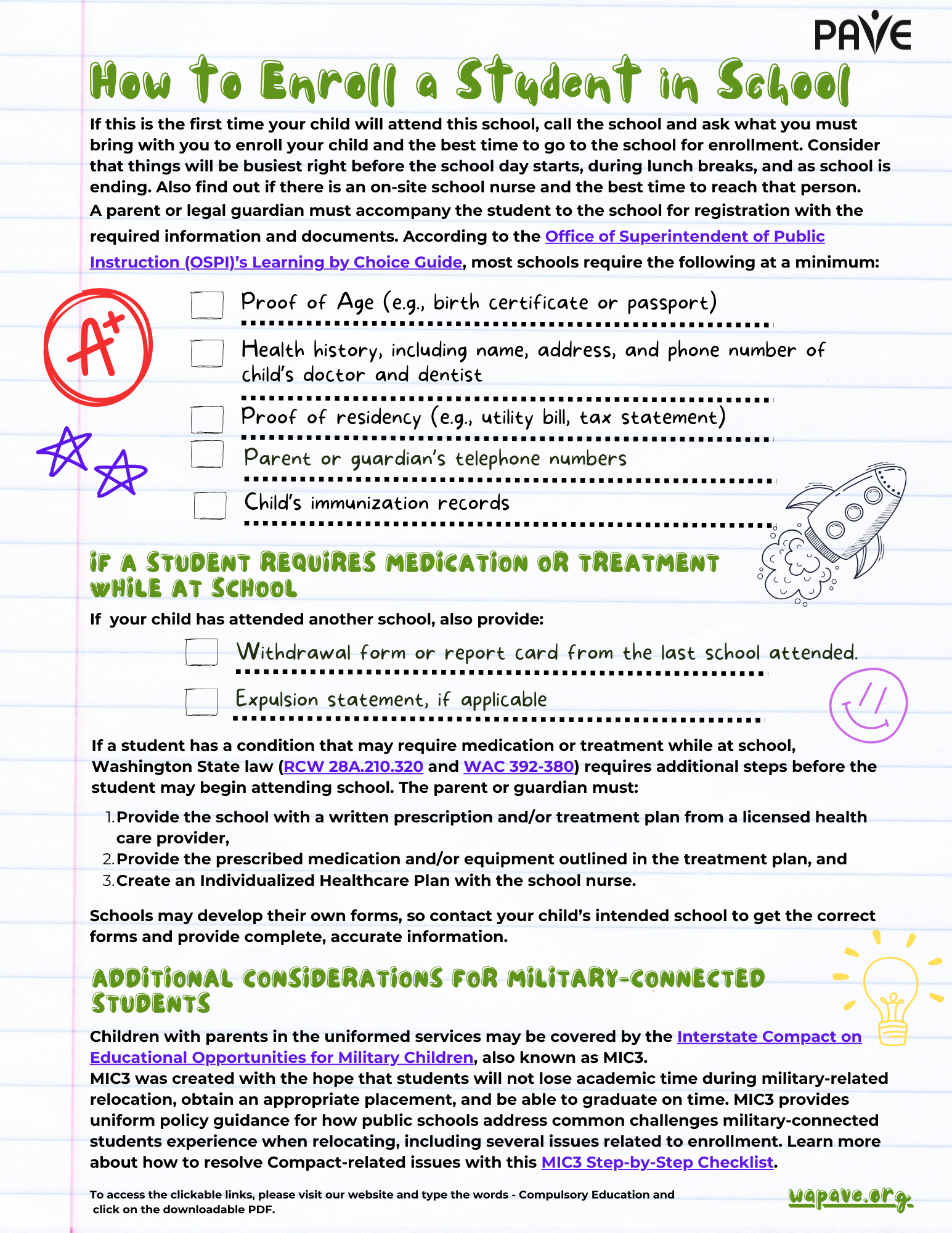The Military Interstate Children’s Compact Commission (MIC3, pronounced “mick three”) is the more commonly used name for the Interstate Compact on Educational Opportunities for Military Children.
A Brief Overview
- This is part of a three-part series on this topic of MIC3. This article continues from Military Interstate Children’s Compact Commission (MIC3), Part 1: The Impact of MIC3 on Military Families and Part 2: Supporting Appropriate Placement and Inclusion of Military Families.
- Under MIC3, schools must place military children in courses and programs based on placement and assessments performed by the sending school.
- Schools and districts may waive course requirements for placement and/or graduation, if a child has met the sending school’s requirements for grade advancement, placement, or graduation.
- A child with an Individualized Education Program (IEP) or Section 504 Plan must receive comparable services and reasonable accommodations or modifications until the receiving school can re-evaluate the child.
- A child may be allowed additional excused absences for deployment-related activities when approved by the superintendent or school principal.
- MIC3 provides guidance for when and how schools must explore alternative means for military children to complete graduation requirements, which may include allowing the student to receive a diploma from the sending school after relocation.
- The receiving school shall accept exit exams conducted by the sending school or, if that is not possible, the receiving school must arrange for the child to get their diploma from the sending school.
Introduction
MIC3’s rules provide consistent guidelines for how public schools address the most common challenges military-connected students experience during a PCS (permanent change of station, the military’s term for “relocation”). MIC3 has been adopted by all 50 states and the District of Columbia. Washington codified MIC3 into state policy as RCW 28A.705.010.
Placement and Attendance
MIC3 helps students obtain appropriate placement by addressing:
- Course and educational program placement.
- Special education services.
- Deployment-related absences.
Course and Educational Program Placement
Under MIC3, after enrollment, the receiving school must place the child in the appropriate courses or programs based on what they were in at the sending school or educational assessments conducted by the sending school. This includes but is not limited to honors, gifted and talented, advanced placement; vocational, technical, and career pathways; and English as a Second Language (ESL). The receiving school may evaluate the child later to ensure the child meets the receiving school’s criteria for eligibility in specific classes or programs. If the receiving school doesn’t offer a similar course or program but another school in the district does, the district may let the child take part in the courses where they are available.
The U.S. Department of Education emphasized the need for timely evaluations and eligibility determinations for military-connected children in the Letter to State Directors of Special Education on Ensuring a High-Quality Education for Highly Mobile Children (issued November 10, 2022).
The MIC3 allows receiving schools the flexibility to waive specific course requirements when a student has met the sending school’s criteria for advancing to the next grade level. For instance, if a student completed a 6th-grade Civics class at the sending school, but the receiving school mandates a different course before moving on to 7th grade, the receiving school can waive this requirement if the student has met the criteria from the previous state. Transcripts should reflect the student’s eligibility for the next grade, and if needed, the receiving school can contact the sending school for detailed course descriptions. MIC3 State Commissioners can assist parents in exchanging information between districts for Compact-related issues, including course content.
However, Department of Defense Dependent Schools (DODDS) overseas are not covered by the MIC3. Families relocating to these overseas schools must request a cross-comparison of credits. The placement of the child in these schools is determined by the DoDDS school system, and it may not follow the same process as state public schools in the United States.
Special Education Services
The Interstate Compact mandates that receiving schools must adhere to laws governing students with special education needs, including the Individuals with Disabilities Education Act (IDEA) and Section 504 of the Rehabilitation Act. When a child arrives with an Individualized Education Program (IEP) or a 504 Plan specifying accommodations, the new school is required to provide comparable services and support to meet the child’s needs. This includes services like Extended School Year (ESY), and these services should continue until assessments indicate that the child no longer requires them. However, MIC3 does not cover Individualized Family Services Plans (IFSPs) because these plans are state-specific, and the availability of early intervention services varies widely among states. Eligibility for services is determined by the receiving state, and there is no guarantee that the child will receive the same services.
In cases involving a child with a Section 504 or ADA Title II plan, the receiving school must provide reasonable accommodations or modifications to ensure equal access to education. Regardless of whether it’s an IEP, 504 Plan, or Title II Plan, the receiving school has the authority to evaluate the child later to assess the continued appropriateness of their educational plan. To facilitate this process, parents are advised to maintain paper copies of their child’s educational plans, service agreements, evaluations, progress reports, and records from sources outside of the school. Sharing these documents, along with unofficial records, can help the receiving school better understand what has and hasn’t been effective for the student in the past.
Deployment
Under MIC3, schools can allow additional excused absences for a child whose military parent is called to duty for, is on leave from, or just returned from deployment to a combat zone or combat support posting. The district superintendent or school principal has the authority to make this decision, as well as to limit the number or length of excused absences to make sure a child doesn’t miss too much school. Often, military families may request this time to celebrate the holiday with a servicemember who was deployed during the calendar event, or to visit family following long separations.
Graduation
MIC3 seeks to help students graduate on time with guidance regarding:
- Transfers during senior year.
- Waiving graduation requirements.
- Exit exams.
Waiving Graduation Requirements
MIC3 instructs the receiving school to waive courses that would otherwise be required for graduation when the student has completed similar courses that met the graduation requirements at the sending school. For example, if the student completed the two of the three mathematics classes required before graduation at the receiving school but the third class, Everyday Math, wasn’t offered at the sending school. Instead, the student took a class called Applied Mathematics that covered similar content. The receiving school may waive the requirement for Everyday Math when shown proof that the student learned the same or similar content in Applied Mathematics.
If a child already qualified to graduate from the sending school (all required coursework completed satisfactorily), and the receiving school does NOT waive their own required coursework, the receiving school must give the child an “alternative means” of getting the required coursework so the student can graduate on time. If the child transferred at the beginning of or during their senior year and all alternatives have been looked at but the child is still not eligible to graduate from the receiving school; then, the receiving school and sending school can make sure the child gets a diploma from the sending school.
Exit Exams
The receiving state shall accept exams from the sending state that are required for graduation, including end-of-course exams, national norm-referenced achievement tests, and alternative testing, in place of testing requirements for graduation in the sending state. If a child transfers to the receiving school in their senior year, and the receiving school can’t accept the exams from the sending school, then the receiving school must arrange for the child to get their diploma from the sending school.
Learn More about MIC3
This is part of a three-part series on this topic of MIC3. Military Interstate Children’s Compact Commission (MIC3), Part 1: The Impact of MIC3 on Military Families introduces the scope and purpose of MIC3. Part 2: Supporting Appropriate Placement and Inclusion of Military Children outlines MIC3’s guidelines for how public schools address challenges related to enrollment and eligibility. This article explores MIC3s placement, attendance, and graduation provisions.
Support with Compact-Related Issues
Parents can use this Step-by-Step Checklist to resolve issues that fall under the provisions of MIC3 For additional support, parents may contact their School Liaison, Parent Center, or MIC3 State Commissioner. As the parent center of Washington State, PAVE provides training to military-connected families, individuals with disabilities, and professionals through the STOMP program. Parents seeking individualized support may contact PAVE through the Get Help Form.
Additional Information
- Military Interstate Children’s Compact Commission (MIC3), Part 1: The Impact of MIC3 on Military Families
- Military Interstate Children’s Compact Commission (MIC3), Part 2: Supporting Appropriate Placement and Inclusion of Military Children
- Letter to State Directors of Special Education on Ensuring a High-Quality Education for Highly Mobile Children
- MIC3 Guide for Parents, School Officials and Public Administrators
- MIC3 Step-by-Step Checklist-Resolve School Issues with the Interstate Compact


